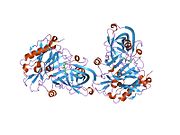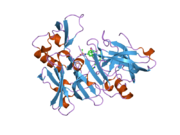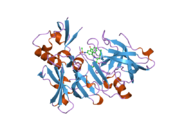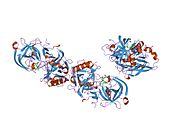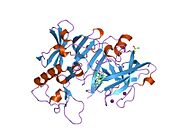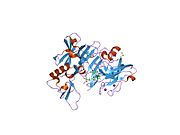Beta-secretase 1
Ensembl | |||||||||
|---|---|---|---|---|---|---|---|---|---|
| UniProt | |||||||||
| RefSeq (mRNA) |
| ||||||||
| RefSeq (protein) |
| ||||||||
| Location (UCSC) | Chr 11: 117.29 – 117.32 Mb | Chr 9: 45.75 – 45.78 Mb | |||||||
| PubMed search | [3] | [4] | |||||||
| View/Edit Human | View/Edit Mouse |
Beta-secretase 1, also known as beta-site amyloid precursor protein cleaving enzyme 1, beta-site APP cleaving enzyme 1 (BACE1), membrane-associated aspartic protease 2, memapsin-2, aspartyl protease 2, and ASP2, is an enzyme that in humans is encoded by the BACE1 gene.[5] Expression of BACE1 is observed mainly in neurons.
BACE1 is an
The BACE1 expression is influenced by the inflammatory state: during AD the cytokines reduce the PPAR1 an inhibitor of BACE1 mRNA.[citation needed]
Role in Alzheimer's disease

BACE1 is the major beta secretase for the generation of
Generation of the 40 or 42
Unlike APP and the
The physiological purpose of BACE's cleavage of APP and other transmembrane proteins is unknown: some studies observed that BACE1 is involved in
However a single residue mutation in APP reduces the ability of BACE1 to cleave it to produce amyloid-beta and reduces the risk of Alzheimer's disease and other cognitive declines.[10][11]
BACE inhibitors
Drugs to block this enzyme (BACE inhibitors) in theory would prevent the buildup of beta-amyloid and (per the
For Alzheimer's disease
This section has an unclear citation style. (January 2024) |
Several companies are in the early stages of development and testing of this potential class of treatment.[13][14] In March 2008 phase I results were reported for CoMentis Inc's candidate CTS-21166.[15]
In April 2012 Merck & Co., Inc reported phase I results for its candidate verubecestat (MK-8931).[16] Merck began a Phase II/III trial of MK-8931 in December, 2012 estimated to be completed in July 2019.[17] In February 2017, Merck halted its late-stage trial of verubecestat for mild to moderate Alzheimer's disease after it was reported as having "virtually no chance" of working according to an independent panel of experts. This came just three months after Eli Lilly & Co. announced its own setback with solanezumab.
In September 2014 AstraZeneca and Eli Lilly and Company announced an agreement to codevelop lanabecestat (AZD3293).[18] A pivotal Phase II/III clinical trial of lanabecestat started in late 2014,[19] but was halted in 2018 before its planned conclusion due to poor results.[20]
Another BACE1 inhibitor that has reached phase II trials is the Eli Lilly's inhibitor LY2886721. The data on phase I trial were first presented at the Alzheimer's Association International conference in 2012. Daily dosing during 2 weeks, reduced BACE1 activity by 50–75% and CSF Aβ42 by 72% (Willis et al., 2012; Bowman Rogers and Strobel, 2013). Recently, Lilly reported that the phase II trial of LY2886721 was terminated due to liver abnormalities that were found in 4 out of 45 patients (Rogers, 2013). This toxicity, however, does not have to be related to the working mechanism of the inhibitor, but can represent off-target effects as the livers of BACE1 knockout mice are normal.
Potential side effects
Tests in mice have indicated that BACE proteases, specifically BACE1, are necessary for the proper function of muscle spindles.[21] These results raise the possibility that BACE inhibiting drugs currently being investigated for the treatment of Alzheimer's may have significant side effects related to impaired motor coordination,[22] though BACE1 knockout mice are healthy.[23]
Relationship to plasmepsin
BACE1 is distantly related to the pathogenic aspartic-acid protease plasmepsin, which is a potential target for future anti-malarial drugs.[24]
References
- ^ a b c GRCh38: Ensembl release 89: ENSG00000186318 – Ensembl, May 2017
- ^ a b c GRCm38: Ensembl release 89: ENSMUSG00000032086 – Ensembl, May 2017
- ^ "Human PubMed Reference:". National Center for Biotechnology Information, U.S. National Library of Medicine.
- ^ "Mouse PubMed Reference:". National Center for Biotechnology Information, U.S. National Library of Medicine.
- S2CID 42481897.
- S2CID 8432207.
- Lay summary in: Phillips ML (September 21, 2006). "Alzheimer's enzyme important for myelin". The Scientist.
- PMID 10801872.
- S2CID 11973104.
- PMID 17576410.
- ^ "Alzheimer's-fighting gene may inspire treatments". July 2012.
- S2CID 4333449.
- PMID 31595293.
- PMID 16644763.
- PMID 17685503.
- ^ "CoMentis BACE Inhibitor Debuts". April 2008.
- ^ "Merck Presents Results of a Phase I Clinical Trial Evaluating Investigational BACE inhibitor MK-8931 at American Academy of Neurology". April 2012. Archived from the original on 2012-07-28.
- ^ "Merck Initiates Phase II/III Study of Investigational BACE Inhibitor, MK-8931, for Treatment of Alzheimer's Disease". December 2012. Archived from the original on 2017-02-27. Retrieved 2012-12-13.
- ^ "AstraZeneca and Lilly announce alliance to develop and commercialise BACE inhibitor AZD3293 for Alzheimer's disease". 16 Sep 2014. Retrieved 8 Oct 2014.
- ^ "AstraZeneca and Lilly move Alzheimer's drug into big trial". Reuters. December 2014. Archived from the original on 2015-10-25. Retrieved 2017-06-30.
- ^ "Update on Phase III Clinical Trials of lanabecestat". 12 June 2018. Retrieved 20 June 2018.
- PMID 23792428.
- S2CID 36382718.
- PMID 11406613.
- PMID 20130644.
- Lay summary in: "Scientists find ideal target for malaria therapy". ScienceDaily (Press release). February 4, 2010.
Further reading
- Hong L, He X, Huang X, Chang W, Tang J (2005). "Structural features of human memapsin 2 (beta-secretase) and their biological and pathological implications". Acta Biochimica et Biophysica Sinica. 36 (12): 787–92. PMID 15592644.
- Johnston JA, Liu WW, Todd SA, Coulson DT, Murphy S, Irvine GB, Passmore AP (2006). "Expression and activity of beta-site amyloid precursor protein cleaving enzyme in Alzheimer's disease". Biochemical Society Transactions. 33 (Pt 5): 1096–100. S2CID 44248549.
- Dominguez DI, Hartmann D, De Strooper B (2006). "BACE1 and presenilin: two unusual aspartyl proteases involved in Alzheimer's disease". Neuro-Degenerative Diseases. 1 (4–5): 168–74. S2CID 26746944.
- Zacchetti D, Chieregatti E, Bettegazzi B, Mihailovich M, Sousa VL, Grohovaz F, Meldolesi J (2007). "BACE1 expression and activity: relevance in Alzheimer's disease". Neuro-Degenerative Diseases. 4 (2–3): 117–26. S2CID 32898359.
External links
- The MEROPS online database for peptidases and their inhibitors: A01.004
- beta-Secretase: Molecule of the Month Archived 2012-11-21 at the Wayback Machine, by David Goodsell, RCSB Protein Data Bank
- Human BACE1 genome location and BACE1 gene details page in the UCSC Genome Browser.
- Overview of all the structural information available in the PDB for UniProt: P56817 (Human Beta-secretase 1) at the PDBe-KB.


